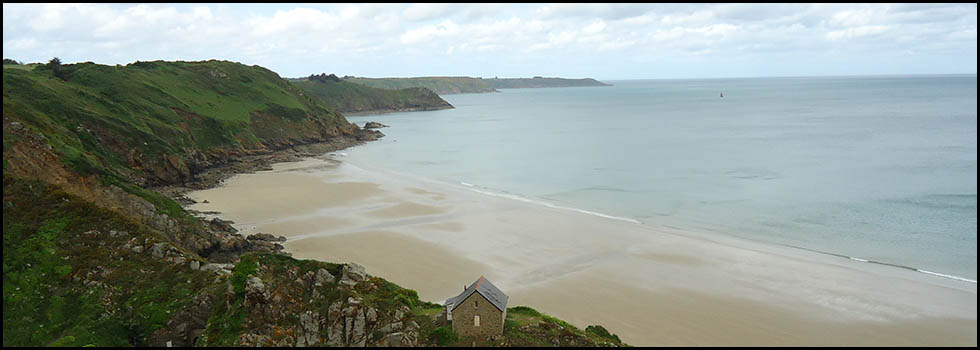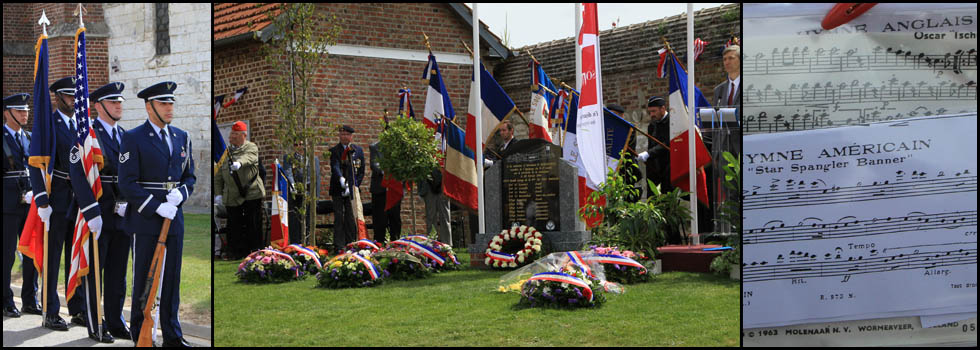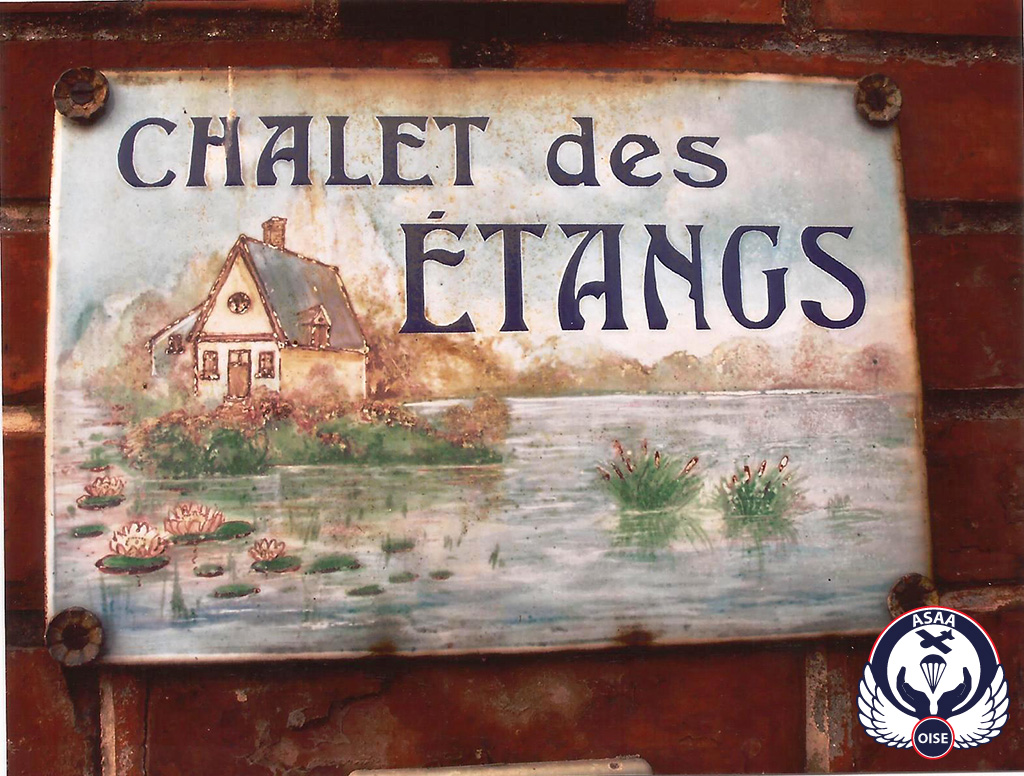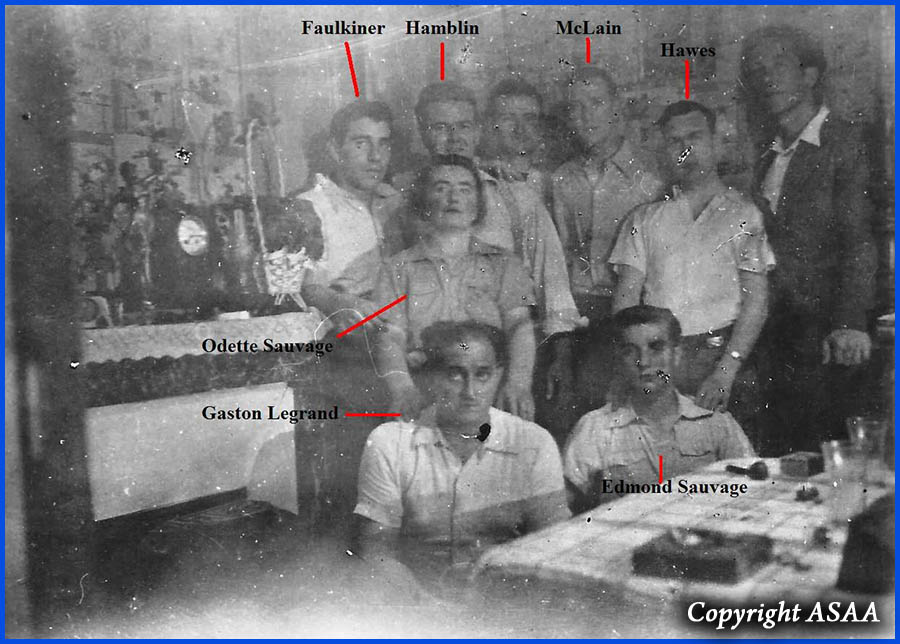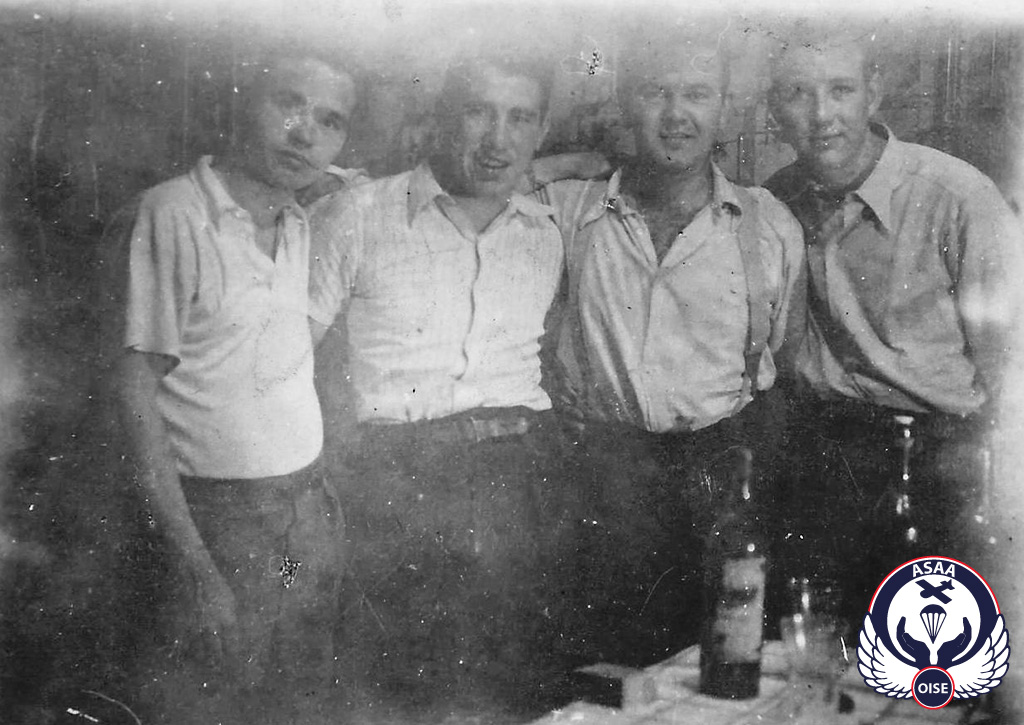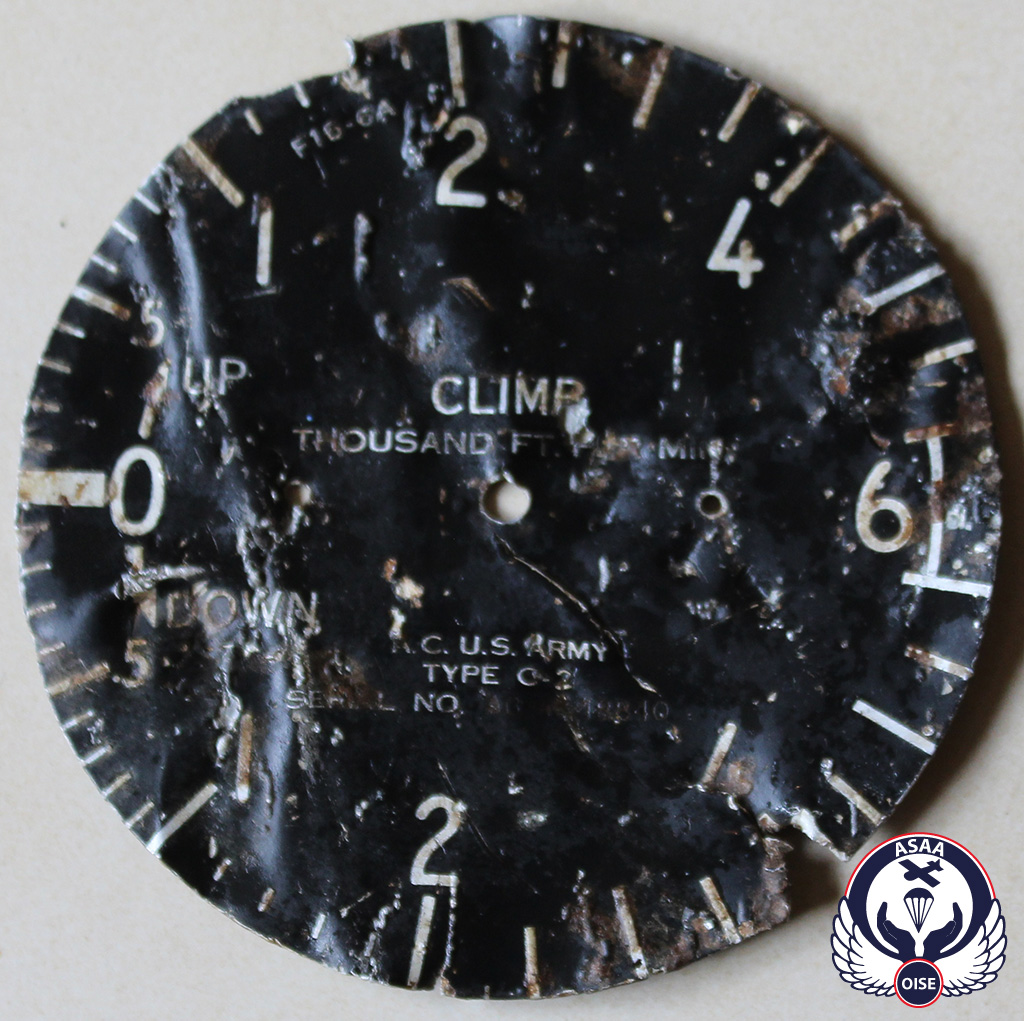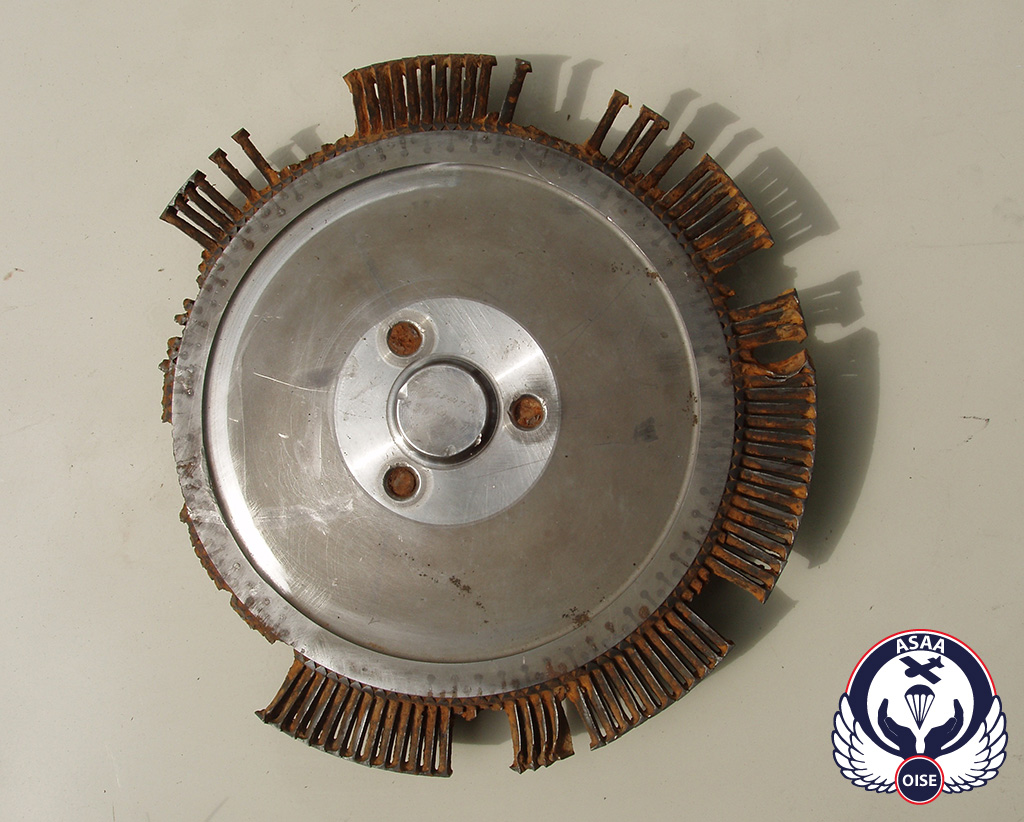6th September 1943
Boeing B-17F # 42-3455 "Lucky Thirteen"
384th Bomb Group
546th Bomb Squadron
8th Air Force
Airion (Oise)
Copyright © 2015 - Association des Sauveteurs d'Aviateurs Alliés- All rights reserved -
En français ![]()
Monday 6th September 1943 : a strategic airstrike on an unprecedented scale was preparing to be launched into the heart of the Reich by the 8th Bomber Command.
No less than 338 Flying Fortresses of different Bomb Groups got ready to take off from their bases which scattered throughout the South of England.
Main target of the day was the city of Stuttgart in southern Germany, and its industrial and aerospace complex of primary importance.
Among the crews assigned to this long and distant mission was that of the B-17 "Lucky Thirteen" of 384th Bomb Group. 21 B-17’s of this Bomb Group started out from the base of Grafton Underwood, Northamptonshire, on this high risk raid.
It was the 6th operational mission of the crew of the B-17F # 42-3455 "Lucky Thirteen" :
| 1st Lt. Russel R. FAULKINER | Pilot | 22 | Evaded | Moundsville, West Virginia |
| 2nd Lt. Warren B. HOLLAND | Co-pilot | POW | Rhode Island | |
| 2nd Lt. Richard J. PEIRCE | Navigator | 27 | POW | Kingsport, Tennessee |
| 2nd Lt. Harry A. HAWES | Bombardier | 26 | Evaded | Kansas City, Missouri |
| T/Sgt. Oscar K. HAMBLIN | Top turret gunner | 22 | Evaded | Kennewick, Washington |
| T/Sgt. Charles L. KIRBY Jr | Radio-operator | 22 | POW | Massachusetts |
| S/Sgt. Harry SAPERSTEIN | Ball turret gunner | 23 | POW | New York |
| S/Sgt. James P. MORLEY | Right Waist gunner | 25 | POW | Pennsylvania |
| S/Sgt. Edward F. RUCH | Left Waist gunnner | 21 | POW | Pennsylvania |
| S/Sgt. William H. ROSS | Tail gunner | POW | Ohio |
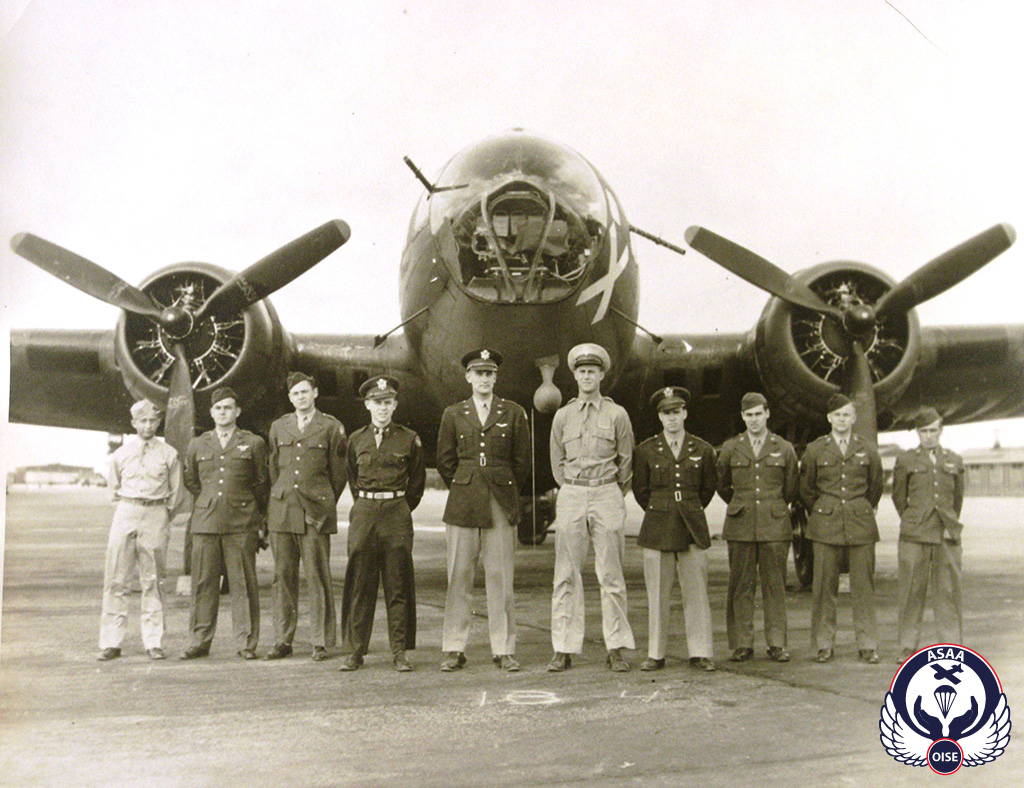
Take off for the aircraft was between 6:00 and 7:00 am. The imposing air force assembled in compact formations in the skies above England and then headed towards France. The coast was reached towards 7:30 am around Berck-sur-Mer, in accordance with the flight plan.
But on entering French territory, the weather deteriorated rapidly. Thick clouds then fog forced the bomber formations to split up. Some aircraft began to break their formation and to disperse. This deterioration of the weather however did not lead to the cancellation of the mission. The consequences will prove disastrous for the 8th Bomber Command.
The hundred or so escort fighters, still with a limited range at this stage of the war, turned around and flew back to England, leaving to its fate the huge armada which continued its flight the East, in the direction of Germany.
The Luftwaffe soon appeared in the sky. The fighters of JG 2 and JG 27 climbed to meet the bomber formations and the fight began. The American gunners fought back with all their weapons, but many Flying Fortresses were hit and shot down, resulting tragically in the loss of their crews.
Around 9:30 am, only about 150 aircraft including the Lucky Thirteen, managed to reach Stuttgart or its surroundings. Some flew beyond their main objective and turned away to secondary targets.
At about 22,000 ft, the aircraft were aligned repeatedly for the final bombing run, searching desperately to identify their target through the clouds that hid the city. Heavy Flak, entered into the action, was becoming more virulent and precise. The aircraft, some of which had suffered damage, dropped their cargo of bombs on any target deemed suitable.
The Lucky Thirteen dropped its bombs after completing three passes over the city from an altitude of 22,000 ft and started its return journey, at the heart of a formation that began to stretch out. The aircraft was damaged by Flak and several times by enemy fighters, leading to the loss of two engines.
1st Lt. Faulkiner and his co-pilot saw that the fuel gauge needles were indicating alarmingly low. The pilot gave the order to transfer fuel from the tanks at the end of the wings to the main tanks. Precious gallons of gasoline evaporated into the air because of big holes in the wings.
The multiple passes over the German city had inevitably led to higher fuel consumption. It quickly became obvious to all the crews that they would not make it back to England.
The course was set for the West. The Lucky Thirteen managed to return to France but was forced to leave the formation in the Reims area. It soon found itself isolated while gradually losing altitude. Despite the large amount of fuel loss and its damaged engines, there was still a chance of reaching the shores of the English Channel and England.
The crew members, at the rear, began to throw overboard the bands of ammunition and radio equipment to lighten up the aircraft.
Again, the Lucky Thirteen was frontally attacked by a FW-190 fighter firing all its guns. Its 20 mm shells particularly hit the cockpit and the radio compartment. 2nd Lt. Holland, T/Sgt. Kirby were seriously injured. The gunner Ruch was hit in knee and the tail gunner Ross in the chest. 1st Lt. Faulkiner, 2nd Lt. Hawes and T/Sgt. Hamblin had minor injuries, hit by small fragments of shrapnel.
It was now clear that the Lucky Thirteen would never reach England. The pilot gave the order to bale out.
After extracting himself from the ball turret, S/Sgt. Saperstein and S/Sgt. Morley went to help the radio operator Kirby who was injured in his back. They fixed his parachute and managed to evacuate him from the aircraft through the bomb bay.
In turn, all the crew abandoned the aircraft while flying over the area of Clermont (Oise) at low altitude. It was about noon – 1:00 p.m.
2nd Lts. Holland and Peirce, T/Sgt. Kirby, as well as S/Sgts. Saperstein, Morley, Ruch and Ross were captured shortly after they hit the ground. One of them fell on the roof of one of the pavilions of the psychiatric hospital of Fitz-James, close to Clermont. The injured airmen were taken under guard to hospitals where they were treated before being sent to prison camps in Germany until the end of the war.
1st Lt. Russel R. Faulkiner, 2nd Lt. Harry A. Hawes and T/Sgt. Oscar K. Hamblin were luckier, being collected by French people.
The Lucky Thirteen, now lost, continued its course and after making a wide turn finally crashed and disintegrate in the trees of the Bois des Moines, in the territory of the municipality of Airion, a few kilometres north of Clermont.
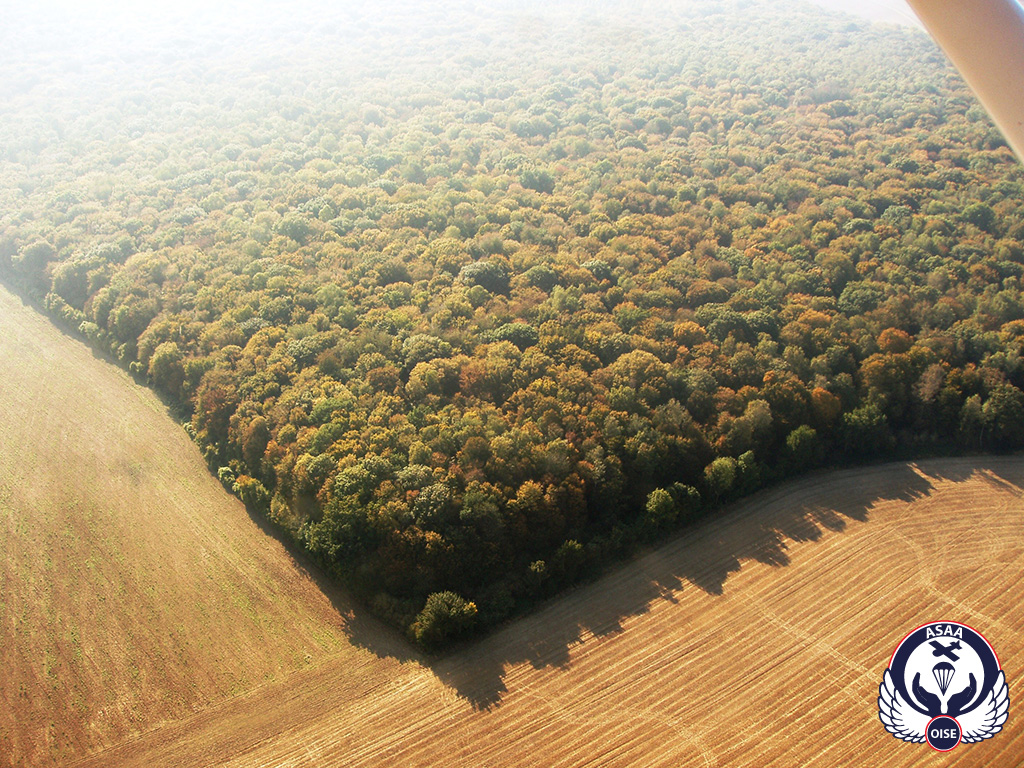
T/Sgt. Oscar K. Hamblin :
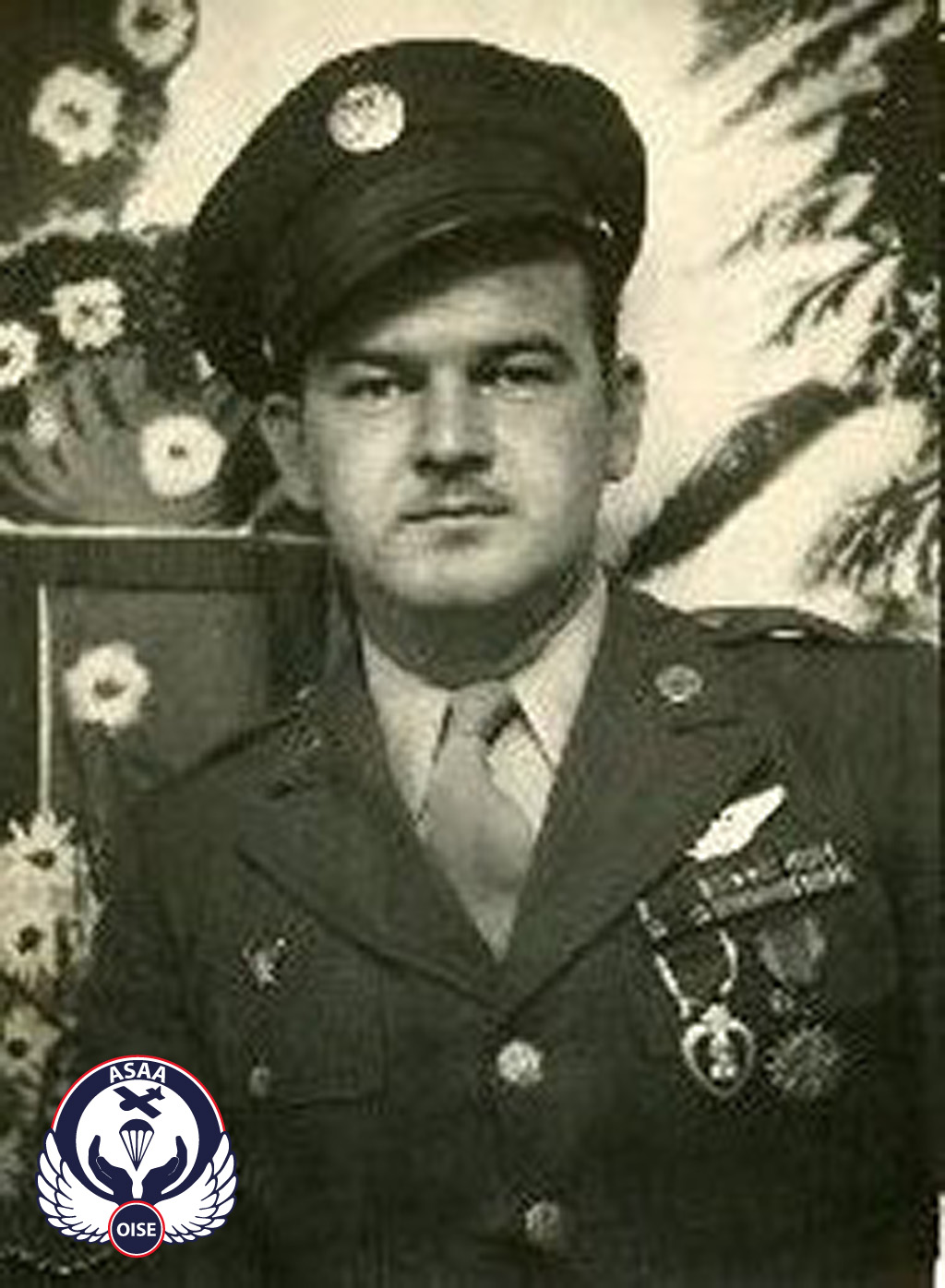 After evacuating the aircraft, T/Sgt Hamblin soon realized that his parachute was carrying him towards a wooded area in the middle of which there were numerous ponds. Pulling his shroud lines, the airman tried to avoid the area which was under his feet but the wind was blowing inexorably. He narrowly managed to avoid some large poplars and fell in the middle of the water. Entangled in his parachute, he was able to immediately operate the valve of his Mae West to rise to the surface and quickly tried to unbuckle his parachute. He eventually used his knife to free himself from his harness.
After evacuating the aircraft, T/Sgt Hamblin soon realized that his parachute was carrying him towards a wooded area in the middle of which there were numerous ponds. Pulling his shroud lines, the airman tried to avoid the area which was under his feet but the wind was blowing inexorably. He narrowly managed to avoid some large poplars and fell in the middle of the water. Entangled in his parachute, he was able to immediately operate the valve of his Mae West to rise to the surface and quickly tried to unbuckle his parachute. He eventually used his knife to free himself from his harness.
T/Sgt. Oscar K. Hamblin just fell in the property of the Chalet des Etangs belonging to Mr. Louis Faulon in Breuil-le Sec.
Mr. Faulon witnessed this incongruous scene. With his wife, he began to put a boat into the water to rescue the airman who was struggling in the middle of the pond. Approaching the white floating corolla and the head which emerged, Louis Faulon asked the airman if he was an American. "Yeah!" came the reply. This response phonetically close to the German "Ja", immediately drastically troubled the mind of Mrs. Faulon who thought he was a German pilot. She immediately took up an oar, ready to hit the "enemy".
Her husband reacted immediately saying that he was indeed an American airman. He was then hoisted aboard the boat and brought back to shore.
They found that the airman was wounded in the thigh and in the back. T/Sgt. Hamblin was quickly taken inside the Faulon’s house while a German fighter, at low altitude, was flying over the area in search of the downed airmen.
Mr. and Mrs. Faulon immediately provided civilian clothes to the rescued airman. His military equipment was quickly buried in the swamps near the property.
After being taken in for the night, T/Sgt. Hamblin was taken early the following morning to the home of Andre Pommery, mayor of the village.
Having been informed, Gaston Legrand then quickly came to take charge of the airman. He took him on his motorcycle to his home, rue du Chatelier in Clermont.
Breuil-le-Sec - The ponds
2nd Lt. Harry A. Hawes :
 2nd Lt. Hawes, suspended from his parachute, was not able to avoid a clump of trees in which he fell, remaining suspended for a few minutes a few meters above the ground. With difficulty, he managed to free himself from his shroud lines and fell on the ground, injuring his ankle slightly. He managed to gather his parachute and hide his equipment under a pile of leaves.
2nd Lt. Hawes, suspended from his parachute, was not able to avoid a clump of trees in which he fell, remaining suspended for a few minutes a few meters above the ground. With difficulty, he managed to free himself from his shroud lines and fell on the ground, injuring his ankle slightly. He managed to gather his parachute and hide his equipment under a pile of leaves.
2nd Lt. Hawes approached the edge of the wood, crossed a road but seeing people in the distance, he decided to hide in the bushes and then in a field of tall grass. In the distance he heard German motorcyclists on the road, heading for the woods. The airman then decided to take a little rest, hiding in the tall grass to avoid being spotted by a German fighter plane that was flying over the area in search of the airmen.
About 7:00 pm, preferring to avoid a small group of Frenchmen seen in the distance, he chose to go to a nearby barn and hid in the flax stored in the loft, spending the night in the midst of rats and mice.
Early the next morning, not having seen anybody close by, 2nd Lt. Hawes cautiously came out the barn. He followed a small tree-lined road. Behind a slope, he then saw a German camp. Making a detour, he moved away before meeting a group of French people picking apples in an orchard. Noticing that the French people had seen him, 2nd Lt. Hawes walked to meet them. Using his translation book, he explained that he was an American and that his aircraft had been shot down returning from a raid over Germany. The French people told him that the Germans were all over the area and made him understand that the only way to go unnoticed at the moment was to help them pick apples.
Meanwhile, one of the men in the group went to inform a man he knew spoke perfect English.

The barn where 2nd Lt. Hawes spent his first night.
2nd Lt. Hawes had landed not far from Ronquerolles, a few kilometres west of the town of Clermont.
The man came back some time later accompanied by Mr Paul Corbiere, owner of the Garenne farm. He questioned him in English and told him that he would be helped to continue his escape. Meanwhile, workers' clothes and food were given to the airman who returned to pick apples until late afternoon.
2nd Lt. Hawes was then hidden in the forest house of Hector Logeais, caretaker of the Domaine de la Garenne. In the early evening, Gaston Legrand and Roland Lucchesi arrived together on a motorcycle near the La Garenne farm. The airman was installed on the bike, between Gaston Legrand who was driving and Roland Lucchesi who was at the back. On the way towards Clermont they met German motorcycle patrols still looking for airmen shot down the day before and safely crossed check points.
At the home of Gaston Legrand, at the heights of the town, 2nd Lt. Hawes had the great surprise of finding his crew mate Oscar K. Hamblin.
1st Lt. Russel R. Faulkiner :
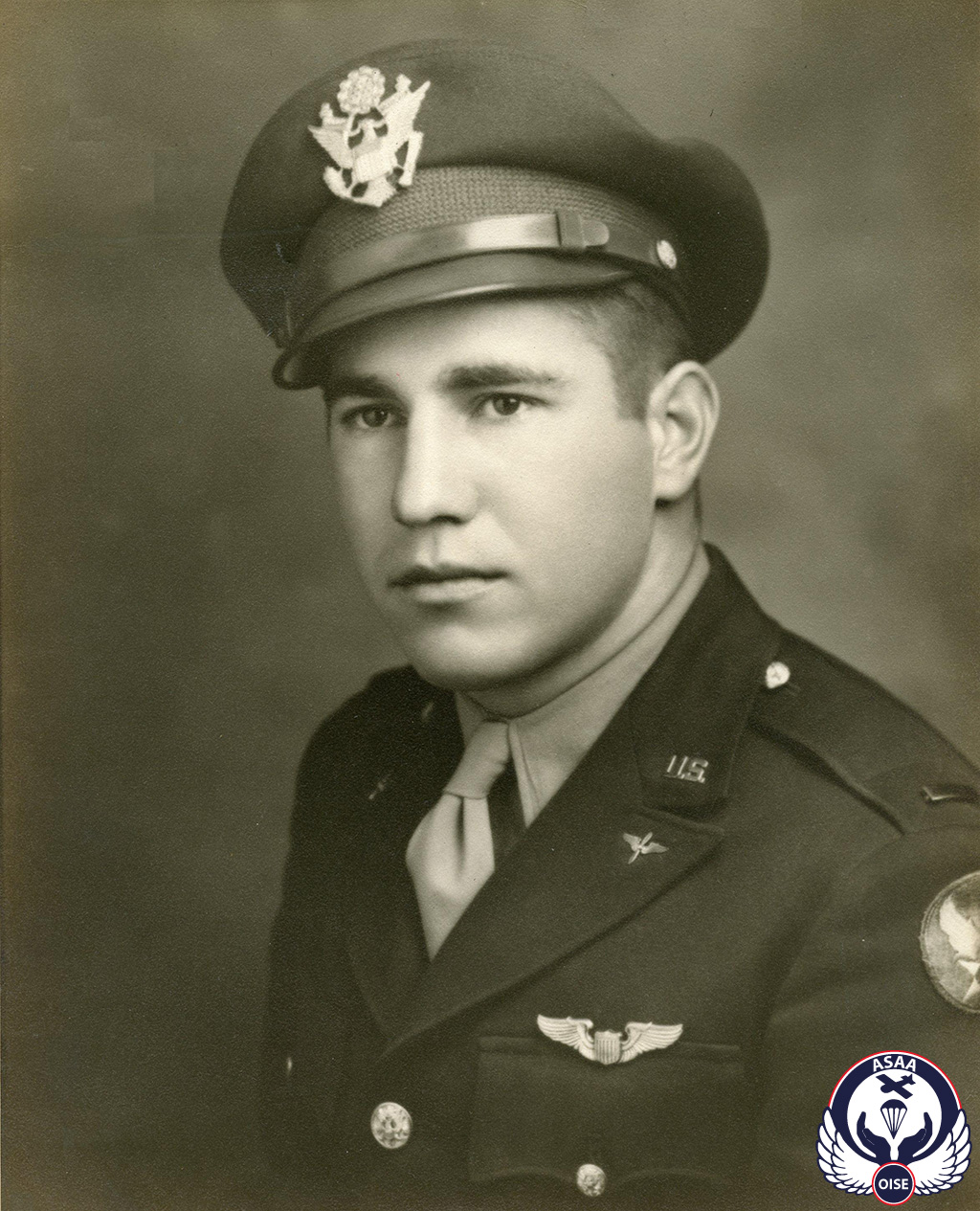 Landing in a field to the west of Clermont, he immediately hid his parachute while a German fighter FW-190 was flying at low altitude over the sector. Quickly, the airman ran to hide in a wood nearby. Seeing a man, he decided to approach him. Speaking a few words of French, he explained that he was an American and was slightly injured. The Frenchman took him to his home in the nearby village. His daughter attended to his wounds and he was given civilian clothes. A man then came but he seemed not to appreciate the help that was given him. Fearing being given away to the enemy, 1st Lt. Faulkiner decided to get away, reaching the wooded area where he had hidden earlier. He stayed hidden throughout the afternoon.
Landing in a field to the west of Clermont, he immediately hid his parachute while a German fighter FW-190 was flying at low altitude over the sector. Quickly, the airman ran to hide in a wood nearby. Seeing a man, he decided to approach him. Speaking a few words of French, he explained that he was an American and was slightly injured. The Frenchman took him to his home in the nearby village. His daughter attended to his wounds and he was given civilian clothes. A man then came but he seemed not to appreciate the help that was given him. Fearing being given away to the enemy, 1st Lt. Faulkiner decided to get away, reaching the wooded area where he had hidden earlier. He stayed hidden throughout the afternoon.
At dusk, going out of the woods to the south-west, he reached Bresles after a few hours walking. It was then about midnight. There was nobody in the streets. After leaving the town, he eventually spent the rest of the night hiding in a haystack.
Around 5:00 am the next morning, 1st Lt. Faulkiner resumed his journey, meeting some French people, sometimes coming across German soldiers. By mid-morning, tired, he approached an old man busy working in a field. Confessing that he was an American and pointing on a map where he wanted to go, the Frenchman decided to take him in. His wife prepared a meal, his wet clothes were taken away and the couple offered him a bed in which he slept up to 5:00 pm. Civilian clothes were given to him and after another meal, the daughter of the house came. She made him understand that it was safer to stay there for the night.
Having been informed, Gaston Legrand arrived the next morning with another man on his motorcycle. They showed the airman photos of Harry Hawes and Oscar Hamblin whom he immediately recognized. 1st Lt. Faulkiner was then quickly taken to Clermont, to the home of Gaston Legrand, where he found his two crewmates who had arrived the day before.
Thus on this day of 8th September 1943, it was three airmen who found refuge in this small house of Clermont.
Gaston Legrand shared the life of Odette Sauvage and the son of the latter, Edmond, aged 17. That first evening in this brick two-story house was an opportunity for Gaston and Odette to open good bottles of cognac and champagne in honour of the arrival of the three airmen fallen from the sky. They immediately considered them as their own children.
Edmond, who spoke some English, helped them to understand each other.
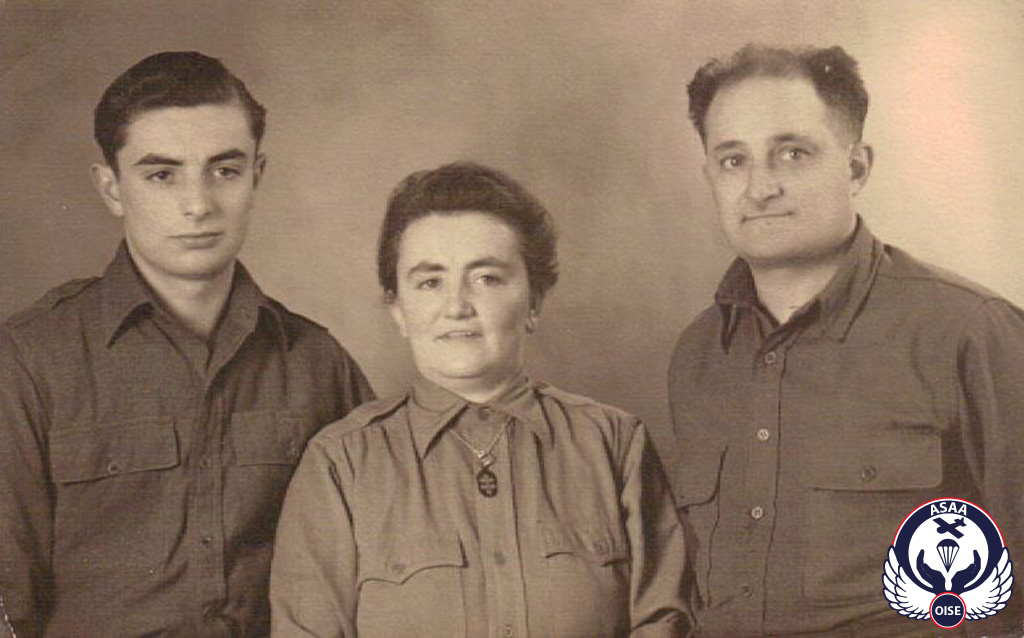
Edmond and Odette Sauvage, Gaston Legrand
They also had to feed and clothe these airmen despite the restrictions due to the Occupation. Odette soon nicknamed "Little Mama" by the Americans, got on with the job. Gaston, a former butcher, scoured the area and managed to clandestinely bring meat and other victuals.
The risks were enormous though. The home of Gaston and Odette was located close to the Kommandantur. From the window of their room upstairs, the airmen could see German soldiers standing guard and roaming the streets.

The Legrand-Sauvage's home where the airmen stayed
On 9th September, the three airmen were joined by another compatriot : S/Sgt. Willard D. McLain. Ball turret gunner aboard the B-17 Black Ghost, 384th Bomb Group, 547th Bomb Squadron, piloted by 1st Lt. Pulcipher, he baled out, like all his crew, in the region of Beauvais on the way back during the same mission over Stuttgart on 6th September, the aircraft being out of fuel. Four of the ten members of the crew were lucky enough to be collected by the population. The other six, some seriously injured, were taken prisoner by the Germans.
After being rescued by various patriots, notably in Andeville, S/Sgt. McLain arrived by car in Clermont, in Gaston Legrand’s home.
This mission of the 6th September 1943 over Stuttgart became a massacre since the 8th Air Force lost 45 Flying Fortresses in the raid, shot down either by German fighters or by Flak or because they had run out of fuel. This was the worst result recorded so far in the war. Five of the B-17s belonged to the 384th Bomb Group. Three of them crashed in the department of Oise.
During their stay, a sincere friendship immediately grew between the airmen and the Legrand-Sauvage family. The four Americans wrote their addresses on a piece of paper so contacts could possibly continue once the war ended. As a precaution, the paper was kept hidden behind the wallpaper above the sideboard in the dining room. The airmen also posed for souvenir photos.
Hawes, Faulkiner, Hamblin et McLain
According to the memories of Harry A. Hawes, the man who took these photos in the dining room was later killed by the Germans. Jean Corroyer, a resistant, was murdered by the Gestapo and the Milice on 6th August 1944 in Clermont. Arrested the same day, his wife Leonie and his son Guy both died in deportation.
These airmen were the first to be hosted by the Legrand-Sauvage family. Throughout the war, this family hosted no fewer than 24 Allied airmen besides French escaped prisoners, despite all the dangers and at the risk of their lives.
The house in the rue du Chatellier was frequently used as a place of clandestine meetings to destroy, by any means, the rule of Hitler. During their stay, Faulkiner, Hawes, Hamblin and McLain became aware that they were now in the hands of an organised structure of the Resistance.
Informed of the presence of the four American airmen, Roland Delnef, alias "Joseph", arrived from Creil to meet them. Head of the Civil and Military Organisation (OCM) he interrogated them and then explained to them everything possible was being done at a local level by specialised escape organisations so they could be taken quickly to the Spanish border-and Freedom. Meanwhile, the four airmen just had to be patient.
On Friday 10th September, after a quick breakfast, Faulkiner, Hawes and Hamblin, around 5:00 am, left the home of the Legrand-Sauvage family. They all had faith in the final victory and all made a promise to meet again after the war. S/Sgt. Willard D. McLain stayed alone, obliged to remain still some time with his guests. The three airmen were discretely taken to the home of Georges Fleury, head of the Centre-Oise area of the OCM, who lived nearby, rue de Mouy. It was then explained to the three Americans what the Organisation had decided.
Around 9:00 am, "Joseph*" and Marcel Gerardot arrived in a small truck with a tarpaulin into the rear of which the three airmen climbed. They were taken to the home of Marcel Gerardot, rue Henri Pauquet, in Creil.
* Roland Delnef alias "Joseph" was arrested on 20th January 1944 in a cafe, place du Châtelet, in Paris, where he had an important appointment. He was deported to concentration camps, firstly to Neuengamme then to Gross-Rosen, to Sachsenhausen and to Mauthausen. He was released on 2nd May 1945.
Marcel Gerardot, Director of the Société Industrielle specialized in the manufacture of boilers, and his wife Renee took in Faulkiner, Hawes and Hamblin until the 15th of September.
It was decided to transfer the three airmen to Chauny, in the department of Aisne, and to entrust them to the Organisation led by Etienne Dromas.
On 15th September, the three Americans were taken to the station at Creil and taken by Roland Delnef, by train, to Chauny. Upon arrival, they were separated. Hamblin was lodged by Etienne Dromas at the town hall in Ugny-le-Gay with McLain, who had managed to reach Chauny after a temporarily stay in Creil.
A resistant right from the word go, Etienne Dromas came from the railway world where he was a draftsman. At the head of the sector B of the Aisne Resistance, he actively fought at the head of his group against the enemy : sabotages of locomotives, of railways, of telephone lines, parachute reception drops ... and helping Allied airmen. Over 80 of them were housed under cover in the region before continuing their escape.
Upon arrival, Faulkiner and Hawes were housed by Alfred Logeon, owner of the garage Saint Charles in Chauny. Two steps away was the Institution Saint Charles occupied by the enemy. It was not uncommon for the two airmen to see German patrols parade and stroll in the town.
Alfred Logeon did not speak English but one of his daughters served as a translator between the family and the airmen who stayed for about 15 days. Like a few days before at the Legrand-Sauvage’s, the two Americans were considered as family members. The Logeon were doing all to offer them the best possible comfort and to feed them despite the restrictions. Quickly Faulkiner and Hawes were photographed. A sheet was stretched across the backyard in front of which the two airmen posed to establish false identity cards and false work certificates. In the living room of the house, there was a collection of Reader's Digest magazines in English which helped the two Americans pass the time.
Mr Logeon very involved in the Resistance, had a transmitter set and was in contact with London for the Organisation "Dromas". During their stay, Faulkiner and Hawes were invited to attend a clandestine meeting which was held in the house. After translation of the proposals, they realized that the Resistance group was about to receive a weapons drop and various equipment for the region. The two Americans volunteered but were disappointed to learn that their presence was not accepted.
On 29th September, Faulkiner and Hawes were again at the Chauny station where they found their companions Hamblin and McLain. Taken in charge by "Petit Georges" (Georges Baledent), a young guide in his twenties who came from Creil, the four airmen boarded a train to Paris.
Once in Paris Nord station, after passing the controls, the escaped airmen rushed into the metro by which they soon crossed the Seine. Coming out onto the streets of Paris, the four airmen were guided on foot to the zoo in the Jardin des Plantes, which was nearby. It was the agreed place of rendezvous. The airmen were expected by this new organisation which had now taken them in charge : it was called the "Burgundy" escape network.
The airmen were separated.
1st Lt. Faulkiner was taken by Madeleine Melot, 60 years old, who took him into her apartment, rue Larrey. He stayed there until the evening of 1st October.
Madeleine Melot* came back to zoo to take in charge 2nd Lt. Hawes and T/Sgt. Hamblin, leaving S/Sgt. McLain. Travelling by metro, she guided the two airmen to the 14th arrondissement, to Simone Levavasseur’s, owner of "La Petite Chocolatiere" at 19 bis rue d'Orléans (which is today rue du Général Leclerc). Hawes and Hamblin were housed above the shop. During the day, they were confined to their room and could see through the window the comings and goings of the Germans in the avenue. In the evening after the shop was closed, they were allowed to go down and could also take a little air in the backyard. The following week, they were visited by Madeleine Melot who had met them at the Jardin des Plantes. She told them that they had to wait before continuing their escape. In the following week, she came back and brought them books and razors and told them that the pilot Faulkiner had left Paris.
* Madeleine Melot was arrested on 19 November 1943. She spent 4 months at Fresnes prison before being deported to Ravensbruck concentration camp. She was repatriated to France in June 1945.
Meanwhile, S/Sgt. McLain, along with another compatriot, F/O Prosser, stayed for about six weeks with Ulysse and Germaine Grassot, rue du Plateau in Fontenay-sous-Bois, in the east suburb of Paris.
On the evening of 1st October, 1st Lt. Faulkiner was brought by Madeleine Melot to the Jardin des Plantes where he was handed over to a young Frenchman who gave him a train ticket. At the Austerlitz station nearby, he joined a group of American and British escapers. Accompanied by three guides, the airmen took the train around 8:00 pm to Toulouse. Shortly after the start, German officers proceeded to control their papers but everything went smoothly.
Around 9:00 am the next morning, they arrived in Toulouse station where the group had to change trains.
Around 3:00 pm, they boarded a train to Foix. During a stop, the group got off the train and continued its journey on a bus, at the foot of the Pyrenees. Arriving in a village, they went into a cafe used as a meeting place and then they were taken to a barn. After four days, the guides did not show up so the airmen took another bus which took them to the village of Auzat, close of the Spanish border. Supported by three guides, then began four long days of walking through the mountains towards Andorra.
After a rest for two days in the Principality, they had four days of additional walk before to take a train to Barcelona, Spain, where they arrived on 9th October. At the British Consulate in the city, all their papers and French money were taken.
The airmen were next taken to Madrid and then, by train, to Gibraltar.
Aboard a plane, 1st Lt. Faulkiner finally left Gibraltar and reached Bristol, England, on 29th October.
With their guides and among other airmen, Hawes and Hamblin eventually left Paris on 22nd October on a night train to Toulouse. Provided with false papers stating that they were deaf and dumb, they were told to only nod if someone was addressing them. Once in the compartment, Harry Hawes, his train ticket in his hat band, opened a newspaper that he had been given. A Frenchman then approached and quickly turned the newspaper that the pilot was holding upside down !
The next day, after reaching Toulouse,the group took another train to Foix and then to Pamiers. From there, they boarded a bus which took them on the twisty mountain roads.
Then began for several days and nights, the perilous crossing of the Pyrenees for the group of 13 escapers including Americans and English but also French, who hoped to join the Free French Forces.
Led by a passeur, the climb to the Spanish border soon took place under the rain and in the wind which accentuated fatigue. Interspersed with short breaks where everyone recovered with whatever he had, the ascent continued to the pass that marked the border. Soon the fugitives reached the first snowfields. The men struggled to progress in the snow that became thicker. Breathing was also more difficult on account of the altitude.
Everyone wondered if he would succeed in reaching the summit, Spain and Freedom. Everyone encouraged each other but nervousness also caused some dissension in the group.
The border ridge was finally passed. Then began the long descent to Andorra. From Andorra, the escapers reached Barcelona on 29th October and presented themselves at the British Embassy. After a night and a day, the airmen, under diplomatic immunity, reached Madrid where they stayed several days.
Then came the departure by train to Gibraltar, where they arrived on 12th November. After a few days, Hawes and Hamblin boarded a plane to Portreath, England, landing there on 18th November 1943.
Soon, in the daily program "Les Français parlent aux Français” (The French speak to the French) sent out via the airwaves of the BBC in London, was broadcast, among others, and despite interference, this personal message: "Les trois lapins blancs sont bien arrivés” (The three white rabbits have arrived safely). It was strickly prohibited to listen to the BBC in France but this message, agreed during their escape, allowed their French rescuers to know they had got back to England.
S/Sgt. Willard D. McLain reached Spain on 17th November, crossing the Pyrenees sometimes with sometimes snow up to his waist. On the Spanish side, his group was arrested by the pro-Franco police. After a stay in a jail, he managed to reach Gibraltar on 15th December, from where he flew, landing in Bristol, England, on 18th December 1943.
Faulkiner, Hawes, Hamblin and McLain, in turn, got back to their base in Grafton Underwood before being repatriated, after several days of sailing, to the United States, where they met their families again.
Between September and December 1943, the Burgundy escape network was responsible for the evacuation through Spain of 150 Allied airmen and about a hundred French.
In September 1944, the department of Oise was liberated and then the war in Europe ended in May 1945. Life gradually returned to normal and years passed ...
However Odette Sauvage, her son Edmond and Gaston Legrand had not forgotten the young boys they had taken in during the dark years of the German occupation.
Thanks to the addresses left by the airmen, the contacts were never interrupted.
As soon as 1947, Edmond Sauvage went across different regions of the United States where he met some of those he had helped to save in 1943 and 1944, such as Glenn E. Camp in Texas, Leonard F. Bergeron in Connecticut, and many others ...
25 years after the war ended, Oscar K. Hamblin, accompanied by his wife and son, made in August 1969, a journey of remembrance to Clermont to personally thank Gaston Legrand, Odette and Edmond Sauvage and also Louis Faulon who helped him get away from the Germans in the first hours of his escape. These moving and warm meetings were an opportunity for everyone to remember events on the very places where they had met for the first time. Oscar Hamblin was able to see again the pond into which he had fallen and also to meet Mr Andre Pommery.
On 1st September 1969, the Hamblin family was officially received at the Town Hall in Clermont where the mayor, Mr Jean Bouet, awarded the airman with the Medal of Honour of the town in the presence of the municipal council and patriotic associations.
In 1976, at the invitation of their American friends, Odette and Gaston, leaving their shop for some time, began in turn to cross the Atlantic Ocean for an odyssey across the United States. Their first visit took place at Oscar Hamblin’s, Washington, where they were welcomed as heroes and with open arms by their host and his family. The visits continued to El Paso, Texas, and to Wisconsin. Formidable meetings which helped to perpetuate throughout their journey, the sincere feelings of friendship forged during the war between this family of rescuers and these men fallen from the sky.
OscarK.Hamblindied on 21st July 1993,aged 72.
Like many airmen, Harry A. Hawes had never forgotten that period of his youth when French patriots had enabled him to avoid capture. He continued his career in the Air Force, serving on various bases in the United States and Japan. He retired in 1962.
Ten years after his friend Oscar K. Hamblin, Harry A. Hawes also came with his wife to Clermont to meet his rescuers during the month of May 1979. The airman was then able to express his appreciation and his gratitude to the Legrand-Sauvage family and to the residents of Clermont who had enabled him to reach Freedom 36 years before.
Harry A. Hawes died in Sacramento, California, on 27th May 2008, at the age of 91.
The pilot of the Lucky Thirteen, Russel R. Faulkiner, continued to serve in the Air Force, retiring in 1970 with the rank of Colonel. In January 1975, he prematurely died of a heart attack in Satellite Beach, Florida. He was 53 years old. He never had the opportunity to return to France.
Willard D. McLain died in January 2010 in Florida, aged 87.
Some debris from the Lucky Thirteen :
Thanks to the Faulkiner, Hamblin, McLain and Legrand-Sauvage families as well as 2nd Lt. Harry A. Hawes for our correspondence and his wife Virginia I had the great honour to meet.
20th October 2018 - Visit of Michael PEALER, grandson of 1st Lt. Russel R. FAULKINER

